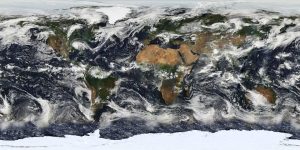As the fight for the environment continues, people are starting to try a variety of tactics to make it easier. Some people are making it easier by using satellite imagery. With satellite imagery, scientists and environmentalists can use top-down images of the area to see when poachers or illegal loggers are making an impact on the forests and stop them.
This isn’t an easy job, and it’s far from perfect right now. However, with more and more high-quality satellite imagery available today, it’s easier than it’s ever been. Take a look at these 5 incredible times satellite imagery helped identify problems and solve them.
1.Amazon Rainforest (Ongoing)
Problems with the Amazon rainforest are ongoing. The forest continues to have problems, largely related to human interference, and despite lots of public attention, it does still have issues with logging and poaching. That’s why some scientists have started to note these problems from above.
This is especially obvious through the Landsat program, a NASA series of satellites that allows for better information regarding the state of the earth. Using seven successive satellites, Landsat has been able to take pictures of the entire Amazon rainforest every two weeks for 47 successive years. This has allowed scientists to better understand the problem and create solutions to help with it.
2.South American Fires (2019)
The fires that happened in South America in 2019 were different than many that preceded it. There were record numbers of hot spots in the early areas, especially in areas with substantial reports of deforestation, causing significant amounts of smoke in the air. The smoke even caused a near-blackout in São Paulo, a giant Brazilian capital.
Satellite imaging was the main reason scientists were able to keep an eye on these fires. In fact, it’s the main reason we know where they stand in relation to other years regarding fires in these areas. Though it took many months for scientists to be able to explain what happened fully, satellite imaging played a key part in it.
3.Peruvian Wildcat Miners (2015)
This was a nearly unprecedented method of combatting deforestation. In 2015, changing satellite images showcased a brand new clearing of rainforest deep within the Amazon, in a reserve that was supposed to remain untouched. In mere months, the Peruvian authorities had found and removed the gold wildcat miners that were driving the deforestation.
The eviction of these miners is a key example of the rapid response that satellite imaging provides. These miners were smart: they started mining deep in the forest, hoping to avoid detection. They would have likely avoided detection for years if not for the top-down images providing insight.
4.Brazilian Rainforests (2004)
2004 was the year Brazil adopted the PPCDAm, or the Action Plan for the Prevention and Control of Deforestation in the Legal Amazon. This was an extremely aggressive plan intended to help curb Amazonian deforestation after decades of not really having any legal recourse for deforestation.
A key player in the PPCDAm was the strengthening of satellite monitoring systems. Although they weren’t perfect, these satellite monitoring systems played an important role in allowing the Brazilian government to monitor the forest from above, and they continue to do so today.
5.Kalimantan (2018)
Kalimatan, Indonesia, has substantial issues with forest lost, and tends to be well-known as a big part of forest lost globally. This is for a variety of reasons, both human-driven and otherwise. Logging activities, rice paddy field growth, and oil palm plantation development have all played a part in Kalimantan’s forest degradation.
In a massive effort to try and better understand these problems, researchers from Finland and Austria utilized satellite data to start monitoring the forest area. Though their research hasn’t had a chance to become widened to the general public, it showcased promising accuracy that many are hopeful to be able to expand in the future.
The Future of the Forest and Satellite Imaging
How can satellite imaging help moving forward? The clarity of satellite imaging still needs some work in certain areas, though high-quality satellite imaging like Worldview 3 is becoming more accessible and more available. As cameras become better and satellites become cheaper, it’s very possible that the general public could see this information made available in incredible detail for the first time. Clearly, these events in the past aren’t the end. Satellite imaging continues to be one of the environment’s biggest allies as governments and companies try harder to combat the increasing global crisis.


